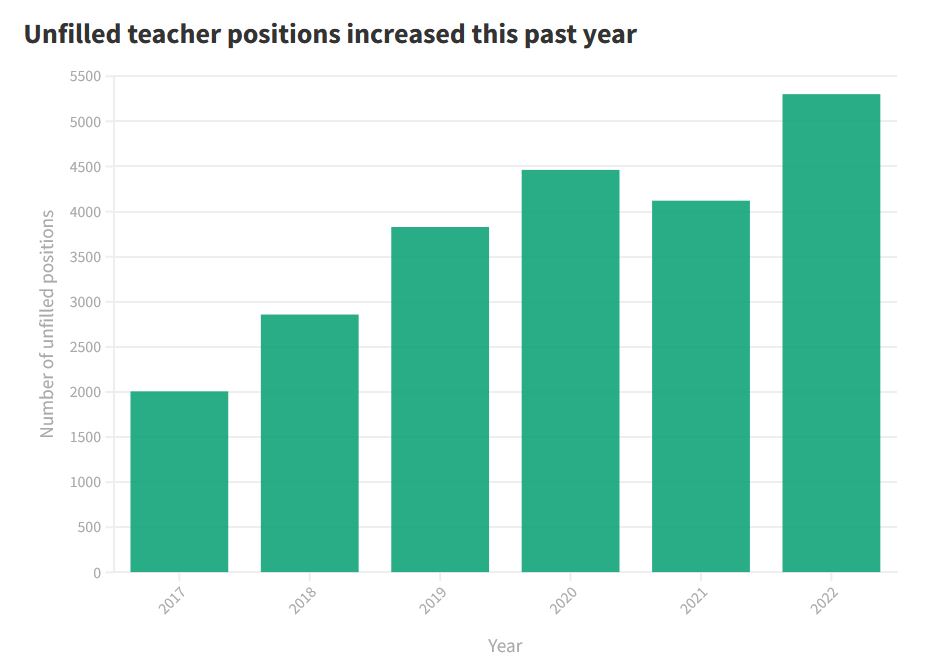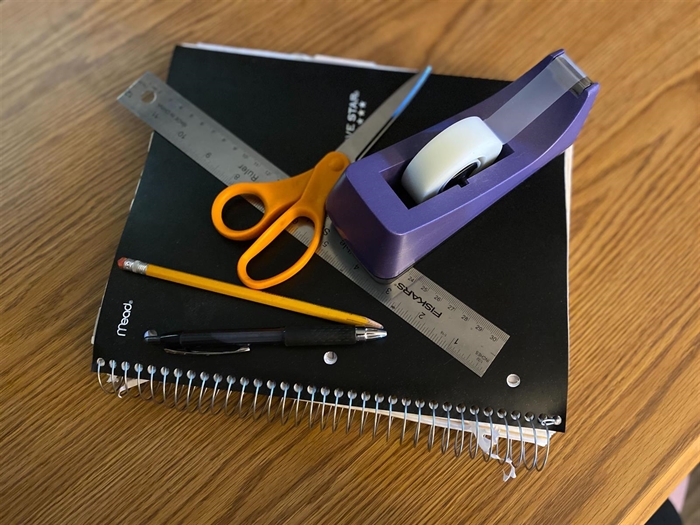SPRINGFIELD – Illinois schools are still grappling with a teacher shortage that seems to only be getting worse, a recent survey by the Illinois Association of Regional Superintendents of Schools shows.
This mirrors the state’s own data, which shows Illinois’ teacher shortage is at the highest level in the last five years. More than 5,300 classroom positions, including administrative and support personnel, went unfilled in 2022, according to the Illinois State Board of Education.
As a result, teachers often have to absorb unsupervised students into their existing classes or fill in for subject areas in which they have no background.
“No matter how much we’re trying, we’re not filling all the positions and the ones we are filling are people who aren’t necessarily qualified to teach what their assignment is,” IARSS President Mark Klaisner said in a recent interview.

The IARSS, a trade group for the public officials who serve as an intermediary between local school districts and the Illinois State Board of Education, has surveyed nearly 700 school districts on the state of the teacher shortage crisis for the past six years. But this year’s survey focused more intently on short- and long-term solutions proposed by school districts statewide.
According to their 2022 survey, 68 percent of districts reported fewer teacher applicants than the year before. And 45 percent of districts reported the shortage in their school had worsened from the year prior.
Klaisner said everyone involved in education needs to be heard when considering policy changes, as problems with teacher recruitment and retention have different causal mixes in different parts of the state.
“There are lots of people working on how to come to solutions,” he said. “Some of it is related to money but a lot is related to reestablishing the teaching profession and, whatever that takes, we need to work with higher ed, we need to work with early childhood and everywhere in between.”
One area of focus, Klaisner said, is improving the pipeline between education institutions and Illinois’ K-12 schools by starting educator recruitment earlier. That could include programs that allow middle schoolers to shadow teachers.
Other policy recommendations in the IARSS report include making college more affordable for prospective educators and increasing the pool of substitute teachers.
Improving the pipeline
The report emphasized the importance of making the teaching profession more desirable for prospective educators, outlining policy recommendations that would lessen financial burdens and encourage greater diversity.
Along with job shadowing programs, he advocated for dual credit programs that allow students to earn some college credit while in high school.
“We need to look for expedited routes that are going to be less expensive,” Klaisner said.
The report also calls for direct state funding to key areas to encourage more diversity within the profession. This includes increasing funding from $4.2 million to $7 million annually for the Minority Teachers of Illinois scholarship; investing more money into the Illinois Teachers Loan Repayment Program which helps pay down student loan debt for Illinois college students that qualify to teach in low-income areas; and further increasing the state’s Monetary Award Program by $50 million.
Those MAP grants go to eligible college students and do not need to be repaid. While the program’s funding has grown to $601 million from about $400 million in the past four years, the report suggested increasing it by $50 million will ensure more teachers from minority communities will receive the grants.
To better fill gaps in the short term, Klaisner pointed to incentivizing teachers to complete additional subject endorsements, which can be done through the ISBE website.
“If you’ve got a good teacher who’s willing to try something new, give them the appropriate endorsement, but then give them three years to be able to complete the coursework to be fully certified in that area,” Klaisner said.
By giving teachers the time and space to complete supplemental endorsements, Klaisner said it will better equip them to fill in potential staffing gaps.
Other recommendations include observing how districts have used federal pandemic-era Elementary and Secondary School Emergency Relief, or ESSER, funds to help teachers get provisional licenses in shortage subject areas. Additionally, the survey recommends strengthening the state’s educator prep programs by showing which paths have stronger results in teacher placement and success.
Several survey respondents also noted that a 2010 state law creating a lower tier of pension benefits for new employees has made the teaching profession less desirable from a compensation standpoint.
Increasing substitute teacher accessibility
When it comes to filling short-term gaps, the report focused on increasing the pool of substitute teachers.
“When you don’t have enough classroom teachers, and then you don’t have enough subs, then you’ve got classrooms that are literally empty. I mean, the children are in the room but there’s no teacher,” said Rep. Sue Scherer, D-Decatur, who was also a teacher for 34 years in Decatur and Maroa-Forsyth.
Last April, Gov. JB Pritzker signed a package of four bills to address the shortage, including House Bill 4798, which allows currently enrolled teaching students with at least 90 credit hours to be licensed as substitute teachers.
According to the survey, 60 percent of respondents said HB 4798 has helped recruit and retain teachers.
In addition, 80 percent of districts support a plan which would increase the number of days retired teachers can substitute from 120 days to 140 days without impacting their retirement benefits.
The number was increased to 120 from 90 in a bill signed in April, Senate Bill 3893, but it was scheduled to expire in 2023. The idea was supported by 79 percent of IARSS survey respondents, and the report advocated for making the extension permanent.
The laws allowing college students to serve as substitute teachers is also scheduled to expire, and the report suggested making it permanent as well.

